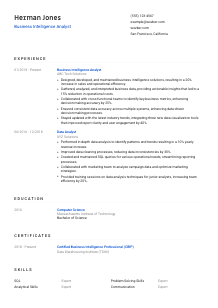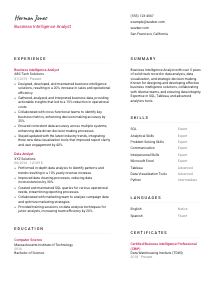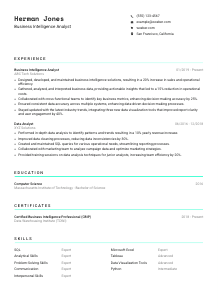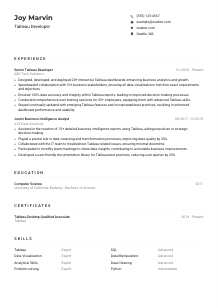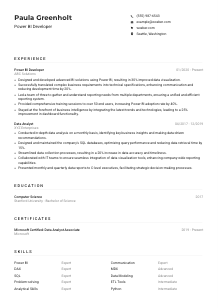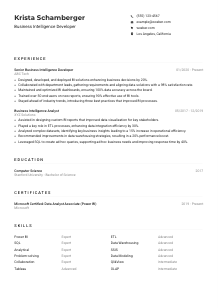Business Intelligence Analyst Resume Example
Unraveling data puzzles, but your resume feels like a riddle? Delve into this Business Intelligence Analyst resume example, decoded with Wozber free resume builder. Grasp how to present your analytical acumen purely, ensuring your career insights are as sharp and clear as the trends you detect!
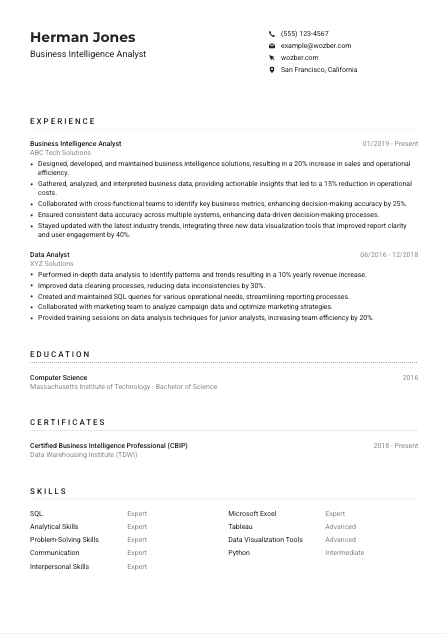
How to write a Business Intelligence Analyst Resume?
Hello, aspiring Business Intelligence Analyst! If you're aiming to stand out in the fast-paced world of data-driven decision-making, your resume is your golden ticket. Crafting an ATS-compliant resume tailored to your dream job isn't just about listing your experiences; it's about storytelling, showcasing your analytical prowess, and connecting the dots like the data maestro you are.
With the help of the Wozber free resume builder, this guide is your roadmap to a resume that not only ticks all the boxes but also tells a compelling story about your unique value proposition. Let's dive in and transform your resume into a data-driven masterpiece!
Personal Details
In the realm of Business Intelligence, your introduction sets the stage for the in-depth analyses you're capable of. Here's how to ensure your personal information resonates with the essence of a Business Intelligence Analyst.
1. Brand Yourself with Your Name
Think of your name as your personal brand. Highlight it using a clean, professional font, ensuring it's the first thing that catches the eye. A strong, clear name at the top of your resume immediately establishes your professional identity.
2. Job Title Alignment
Position the job title 'Business Intelligence Analyst' prominently near your name. This aligns your persona with the role at first glance, serving as a strategic signal to the hiring manager that you're tailor-made for the position.
3. Essential Contact Details
Keep your phone number and email address professional and error-free. A straightforward format such as firstname.lastname@email.com speaks volumes about your attention to detail—a crucial trait for a Business Intelligence Analyst.
4. Location Matters
Including 'San Francisco, California' in your resume zeroes in on a critical requirement from the get-go. This small detail enhances your resume's relevance, reassuring employers of your candidacy's logistical viability.
5. Digital Professional Presence
A LinkedIn profile or a personal portfolio that reflects your resume boosts your credibility. Ensure it's up-to-date with relevant projects, reflecting your expertise in SQL, Tableau, or other data visualization tools.
Takeaway
Your personal section is more than a formality—it's your introduction to the world of Business Intelligence. Craft it with care, ensuring every detail aligns with your professional persona and the target role. Your resume's opening act is a powerful tool in setting the right tone and making a memorable first impression.





Experience
In the analytical symphony that is your professional journey, every role you've played is a note that contributes to a beautiful melody. Here's how to ensure your experience section sings with relevance and precision.
- Designed, developed, and maintained business intelligence solutions, resulting in a 20% increase in sales and operational efficiency.
- Gathered, analyzed, and interpreted business data, providing actionable insights that led to a 15% reduction in operational costs.
- Collaborated with cross‑functional teams to identify key business metrics, enhancing decision‑making accuracy by 25%.
- Ensured consistent data accuracy across multiple systems, enhancing data‑driven decision‑making processes.
- Stayed updated with the latest industry trends, integrating three new data visualization tools that improved report clarity and user engagement by 40%.
- Performed in‑depth data analysis to identify patterns and trends resulting in a 10% yearly revenue increase.
- Improved data cleaning processes, reducing data inconsistencies by 30%.
- Created and maintained SQL queries for various operational needs, streamlining reporting processes.
- Collaborated with marketing team to analyze campaign data and optimize marketing strategies.
- Provided training sessions on data analysis techniques for junior analysts, increasing team efficiency by 20%.
1. Analyze the Job Requirements
Examine the job description intensely. Identify keywords like 'data visualization', 'SQL', or 'cross-functional collaboration'. These are not just buzzwords, but beacons that guide the narrative of your professional story.
2. Chronology and Context
List your roles from the most recent backward, ensuring clarity in job titles, companies, and dates. This transparency not only showcases your career trajectory but also aligns your experiences with the role's requirements.
3. Achievement-Oriented Statements
For each role, articulate your accomplishments, focusing on how you've impacted your previous employers. Use metrics wherever possible, such as 'increased sales by 20%' or 'reduced operational costs by 15%', to quantify your contributions.
4. Quantify Your Impact
Numbers tell a compelling story. Including metrics that demonstrate your achievements provides a tangible measure of your effectiveness and showcases your analytical capability—a must for a Business Intelligence Analyst.
5. Relevance is Key
Stick to the plot! Ensure every point under your experiences relates directly to the Business Intelligence Analyst role. Irrelevant detours can detract from the powerful narrative you're building.
Takeaway
Consider each bullet point in your experience section a testament to your competence and a preview of the value you'd bring. This isn't just a list—it's a persuasive essay on why you're the ideal candidate for the role. Tailor it meticulously, and let your professional journey tell a story of success, growth, and unmatched potential.
Education
Your educational background doesn't just show that you've learned; it demonstrates a commitment, a base of knowledge, and a capacity for growth. Here's how to ensure your education section underscores your foundation for the Business Intelligence Analyst role.
1. Align with Key Requirements
The job description asks for a 'Bachelor's degree in Computer Science, Business Analytics, or related field.' If your degree aligns with this, make it prominent. Your degree is not just a credential, but a direct match to the role's foundational requirements.
2. Structure and Simplicity
Maintain a clear, easy-to-follow format. Start with your degree, followed by the field of study, institution's name, and graduation year. This streamlined approach allows hiring managers to quickly verify your educational qualifications.
3. Tailoring Educational Insights
While the 'Bachelor of Science in Computer Science' directly matches the job criteria, mentioning relevant coursework or projects can further showcase your preparedness for the specific demands of a Business Intelligence Analyst.
4. Highlighting Complementary Education
Should you have additional certifications or courses that enhance your degree, such as a 'Certified Business Intelligence Professional' certification, make it known. This shows your dedication to expanding your skill set and staying abreast of industry trends.
5. Academic Achievements and Extracurriculars
If you've earned honors, participated in relevant clubs, or completed significant projects, mention these. They reflect not only your intellectual prowess but also your engagement and initiative—qualities that enrich your candidacy.
Takeaway
Think of your education section as the bedrock upon which your career is built. It's not just about where you've studied; it's about how your learning journey aligns with and prepares you for the responsibilities of a Business Intelligence Analyst. Craft this section to reflect not just your qualifications, but your readiness and eagerness for the role.
Certificates
In the ever-evolving field of business intelligence, staying updated with the latest tools and methodologies is crucial. Certifications not only demonstrate your commitment to continuous learning but also bolster your expertise. Here's how to curate a certificates section that shines.
1. Identify Relevant Certifications
While the job description might not specify required certifications, including relevant ones, such as 'Certified Business Intelligence Professional', positions you as a dedicated and knowledgeable candidate. It reflects a proactive attitude towards honing your craft.
2. Prioritize Pertinence
List certifications that directly relate to business intelligence, data analysis, or similar fields. This selection process ensures that your resume remains focused and relevant, showcasing your specialized skills and knowledge.
3. Include Validity Dates
If applicable, mention the acquisition or expiration dates of your certifications. This detail provides hiring managers with a sense of the currency of your expertise, especially important in a field as dynamic as business intelligence.
4. Commit to Continual Learning
The landscape of business intelligence is constantly changing. Highlight your readiness to stay ahead of the curve by pursuing new certifications and keeping existing ones up-to-date. This communicates initiative and a genuine passion for your field.
Takeaway
Your certificates showcase more than just skill—they highlight your dedication to excellence in the field of business intelligence. By carefully selecting and presenting your certifications, you underscore your commitment to professional growth and your capacity to bring cutting-edge solutions to the table.
Skills
The skills section is like a quick-reference guide to your professional capabilities. In the context of a Business Intelligence Analyst, this means highlighting not only your technical acumen but also your analytical insight and collaborative spirit. Let's tailor your skills for maximum impact.
1. Extract from Job Description
Begin by identifying both hard and soft skills mentioned in the job description, such as proficiency in 'SQL', 'analytical skills', and 'communication'. These are your guideposts for aligning your skills section with the role's expectations.
2. Prioritize Direct Matches
Focus on listing skills that directly match those outlined in the job description. This congruency signals to the ATS and the hiring manager that your toolkit is not just impressive, but perfectly suited for the role's unique demands.
3. Organize for Impact
While it might be tempting to include every skill you possess, prioritize clarity and impact. Arrange your skills in a way that draws attention to your strongest areas, ensuring that your proficiency in key tools and methodologies shines through.
Takeaway
Your skills section is more than a list; it's a mosaic of your professional capabilities. Each skill you include is a piece of the puzzle that completes the picture of an exemplary Business Intelligence Analyst. By thoughtfully curating this section, you showcase not just your proficiency, but your strategic understanding of the role's requirements.
Languages
In a world where data knows no borders, fluency in multiple languages can set you apart as a Business Intelligence Analyst. This section is your chance to highlight linguistic skills that enhance your ability to communicate insights across cultures and markets.
1. Match Job Language Requirements
The job description explicitly requires 'Advanced proficiency in English.' Ensure this is clearly indicated in your resume. If there are additional language requirements or preferences, prioritize them accordingly.
2. Emphasize Key Languages
Beyond the essential languages, include others that you are fluent in. This showcases your versatility and readiness to engage in a global workspace, expanding the reach of your analytical insights.
3. Indicate Your Proficiency Level
Be transparent about your level of proficiency in each language, using terms like 'native', 'fluent', and 'intermediate'. This accuracy provides a clear understanding of your communication capabilities.
4. Highlight the Global Impact
Even if not explicitly required, showing linguistic versatility can be a significant asset, particularly in roles that have a global scope or involve multinational teams. It underscores your ability to navigate and analyze diverse datasets.
5. Embrace Your Multilingual Advantage
In a role that often involves deciphering complex patterns and communicating findings, your multilingual skills amplify your ability to break down barriers and make data accessible to a broader audience.
Takeaway
Your proficiency in multiple languages is a testament to your ability to operate in the international arena of business intelligence. This section is not just about linguistic skills; it's about showcasing your adaptability and your capacity to bring insights to life for diverse audiences. It's a reflection of your global mindset and your readiness to make a profound impact in a connected world.
Summary
Your summary is the opening act of your professional narrative. This is where you distill your journey, skills, and ambitions into a concise and compelling elevator pitch that captures the essence of what makes you the ideal candidate for the Business Intelligence Analyst role.
1. Digest the Job
Start with a deep understanding of the job description. Identify its core requirements and how your experience aligns with them. This knowledge will help you craft a summary that speaks directly to what the role entails and why you're a perfect fit.
2. Lead with Your Professional Identity
Introduce yourself as a Business Intelligence Analyst, emphasizing your proficiency in critical areas such as data analysis, SQL, and Tableau. This sets the tone and immediately aligns your profile with the job at hand.
3. Highlight Your Unique Value
Showcase specific achievements and skills that set you apart. Mention how you've designed business intelligence solutions, collaborated with teams to identify key metrics, or integrated new data visualization tools. This is your chance to shine with uniqueness.
4. Brevity and Impact
Keep your summary concise but powerful. Aim for a few punchy lines that encapsulate your expertise and potential contribution. Remember, this is your hook to entice the hiring manager into wanting to read more about you.
Takeaway
A meticulously crafted summary is your chance to make a memorable impact. It's not just an introduction but a powerful statement of intent and capability. As you tailor it to the Business Intelligence Analyst role, let it reflect your analytical acumen, your career achievements, and your vision for the future. Let your summary not only introduce you but advocate for your place within the organization.
Launch Your Journey with Precision
Congratulations on navigating the intricacies of crafting a resume that's not just ATS-compliant but also a true reflection of your unique professional identity as a Business Intelligence Analyst. Remember, each section of your resume is a chapter of your career story, leading the reader through a journey of growth, achievement, and potential. With Wozber's free resume builder, ATS-friendly resume templates, and ATS resume scanner, you have all the tools at your disposal to create a resume that matches the job description and showcases your prowess in business intelligence.
As you finalize your resume, think of it as your dossier for success—a carefully curated document that opens doors to new opportunities. Go on, submit your resume with confidence, and prepare to embark on the next exciting chapter of your career!

- Bachelor's degree in Computer Science, Business Analytics, or a related field.
- Minimum of 3 years of experience in business intelligence, data analysis, or data visualization.
- Proficiency in SQL, Tableau, and other data visualization tools.
- Strong analytical and problem-solving skills with the ability to work with large data sets.
- Excellent communication and interpersonal skills to collaborate with teams across the organization.
- Advanced proficiency in English necessary.
- Must be located in San Francisco, California.
- Gather, analyze, and interpret business data to provide actionable insights and support strategic decision-making.
- Design, develop, and maintain business intelligence solutions and data visualizations.
- Collaborate with cross-functional teams to identify and prioritize key business metrics and KPIs.
- Ensure data accuracy, consistency, and integrity across various systems and databases.
- Stay updated with the latest industry trends and best practices in business intelligence and analytics tools.





